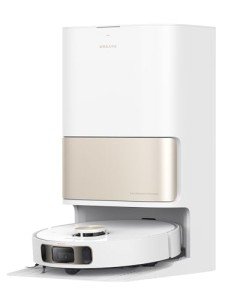The Rise of Robotic Vacuums: A Comprehensive Overview
In today's fast-paced world, innovation is consistently evolving to make our lives easier, and the household cleaning section has actually seen one of the most notable developments: the robotic vacuum. This intelligent device not only saves time and energy however likewise makes sure a cleaner home environment with minimal manual effort. This short article looks into the remarkable evolution of robotic vacuums, how they work, their benefits and drawbacks, market trends, and future instructions.
The Evolution of Robotic Vacuums
Robotic vacuums have made fantastic strides since their inception in the late 1990s. The first commercially readily available robotic vacuum was presented in 1996, followed by various designs, each created with intensifying elegance and features. Here is a quick timeline of robotic vacuum evolution:
| Year | Event |
|---|---|
| 1996 | Introduce of the first robotic vacuum (Electrolux's Trilobite) |
| 2002 | iRobot Roomba is launched, making robotics mainstream |
| 2010 | Introduction of advanced mapping and navigation functions |
| 2017 | Integration of AI and smart home compatibility |
| 2022 | Launch of extremely advanced models featuring self-emptying dustbins |
How Robotic Vacuums Work
Robotic vacuums make use of a mix of sensing units, algorithms, and expert system to browse areas successfully. Here's how they run:
- Navigation: Most robotic vacuums utilize a series of sensing units to discover obstacles and navigate around furnishings. Some high-end designs integrate LIDAR (Light Detection and Ranging) innovation to create detailed maps of the environment.
- Cleaning Mechanisms: They are geared up with rotating brushes and suction mechanisms to collect debris from various surfaces. Depending on the design, they can shift in between carpets and tough floors perfectly.
- Smart Features: Many modern robotic vacuums are Wi-Fi allowed, permitting users to control them remotely by means of a mobile phone app. Features typically consist of scheduling, mapping out cleaning courses, and combination with other smart home devices.
- Self-Maintenance: High-end units may come with self-emptying capabilities, where the robot can dock itself to a base that gathers dust and debris without human intervention.
Advantages of Robotic Vacuums
Robotic vacuums have actually gathered tremendous popularity, and for good reasons. Here are a few of the most significant benefits:
- Time-Saving: Automating the cleaning procedure allows users to engage in other significant activities.
- Efficient Cleaning: Regular cleaning can be quickly attained by arranging the robot to clean everyday or weekly, keeping dirt and irritants at workable levels.
- Compact Design: Their little size allows them to fit under furnishings and in hard-to-reach places.
In spite of their benefits, robotic vacuums likewise come with constraints:
- Limited suction power: While they are efficient for maintaining tidy floorings, they may not match the deep cleaning of traditional vacuums.
- Battery life: Most designs require to return to their dock after a particular duration of use.
- Preliminary expenses: High-quality robotic vacuums can be expensive, though rates have been decreasing with improvements in innovation.
Current Market Trends
The market for robotic vacuums is expanding rapidly. According to a recent marketing research report, the worldwide robotic vacuum cleaner market is expected to reach ₤ 7.2 billion by 2027, growing at a CAGR of 23.5%, driven by several factors:
Increased Adoption of Smart Home Devices
The rise of smart home technology has motivated customers to incorporate robotic vacuums into their households. Numerous robotic vacuums work flawlessly with home assistants like Amazon Alexa and Google Assistant, simplifying their operation.
Advances in Robotics and AI
As the innovation behind robotic vacuums progresses, designs are being geared up with better navigation systems, AI algorithms for learning individual cleaning routines, and enhanced functions for specific floor types.
Focus on Health and Hygiene
The increased awareness of cleanliness and health, especially due to recent international events, has actually driven consumers to buy devices that frequently get rid of dust, allergens, and family pet hair from their homes.
Future Directions
As technology advances, robotic vacuums are anticipated to evolve further, incorporating functions that increase their efficiency in households. Expected developments include:
- Improved AI Learning: With developments in artificial intelligence, future designs will be much better at comprehending their environment and adapting to the requirements of their owners.
- Multi-Purpose Design: Potential future designs may include functions for mopping, disinfecting, and air purification in addition to vacuuming.
- Sustainability: As eco-consciousness increases, manufacturers are most likely to focus on energy effectiveness, recyclable materials, and sustainable production practices.
Frequently Asked Questions About Robotic Vacuums
1. Can robotic vacuums vacuum on carpet?Yes, a lot of robotic vacuums can shift between various floor types, consisting of carpets and tough floorings. 2. How typically should I run my robotic vacuum?It depends
on your home's cleaning requirements, but numerous users
arrange their robotic vacuums to run daily or every number of days. 3. Are robotic vacuums worth the investment?For lots of consumers, the time saved and benefit offered by robotic vacuums makes them beneficial,
particularly for busy homes. 4. Can I control my robotic vacuum remotely?Most modern-day robotic vacuums can be controlled through a smartphone app, permitting scheduling and tracking from anywhere. 5. Do I still need a traditional vacuum cleaner?While robotic vacuums effectively handle daily cleaning, a conventional vacuum may still be required for deep cleans or toughermesses. The development of robotic vacuums shows a substantial leap in automating housework, integrating ingenious innovation with easy to use operation. As the trend towards smart homes continues and consumer expectations evolve, robotic vacuums will likely keep improving, providing ever-greater benefit and effectiveness in maintaining tidy living areas. As best robot vacuum deals consider the prospective advantages and restrictions of these devices, it is clear that robotic vacuums have solidified their track record as invaluable tools in modern-day home management.

